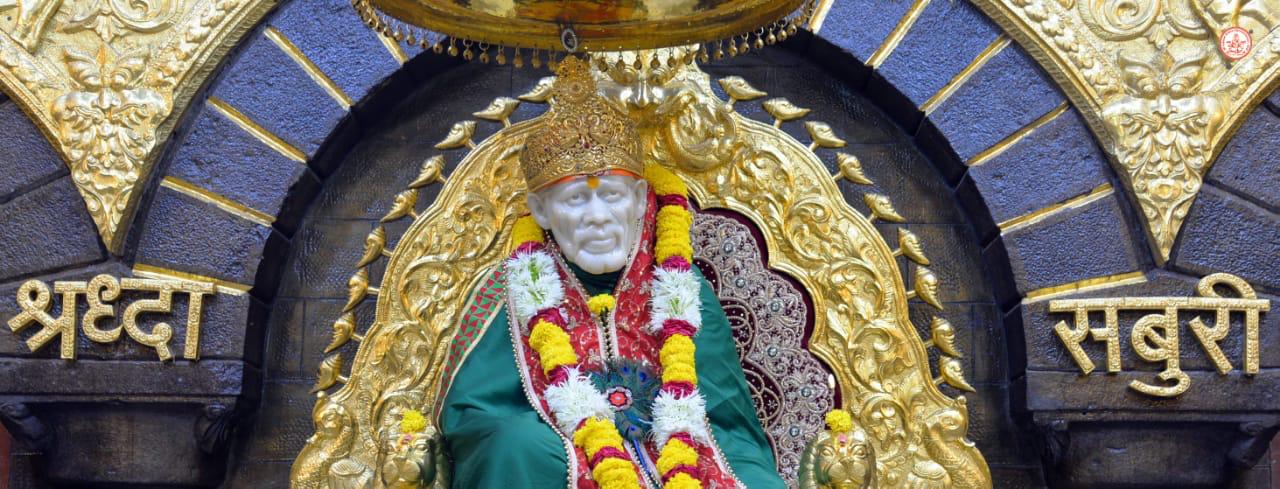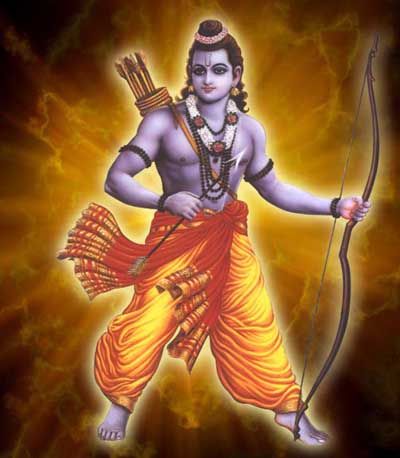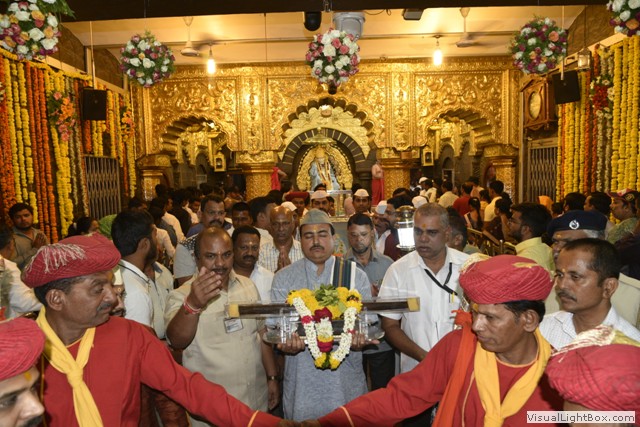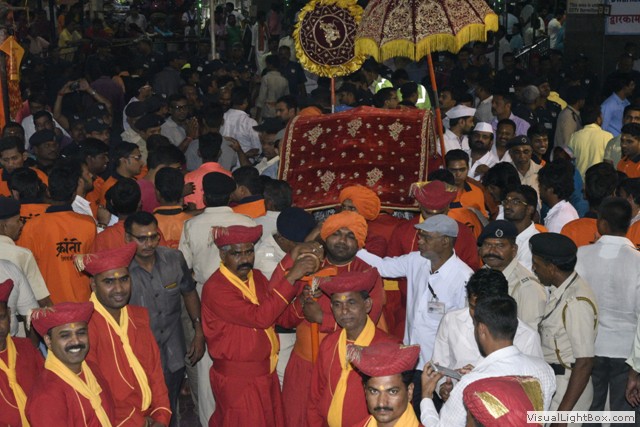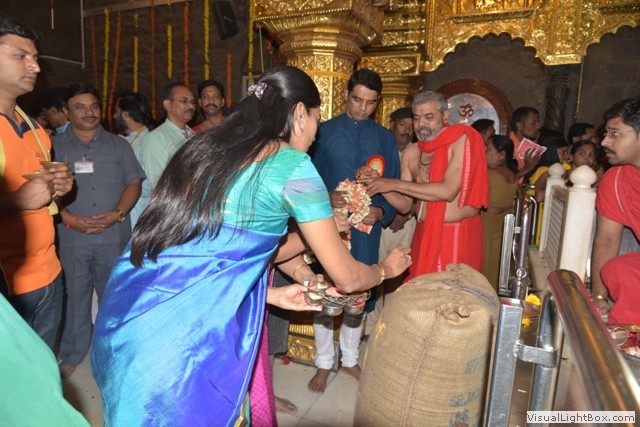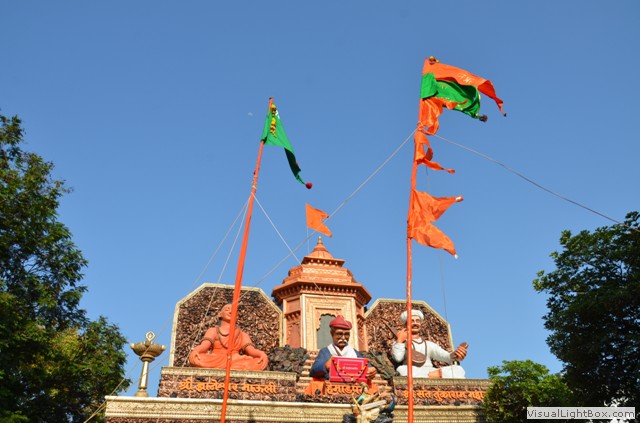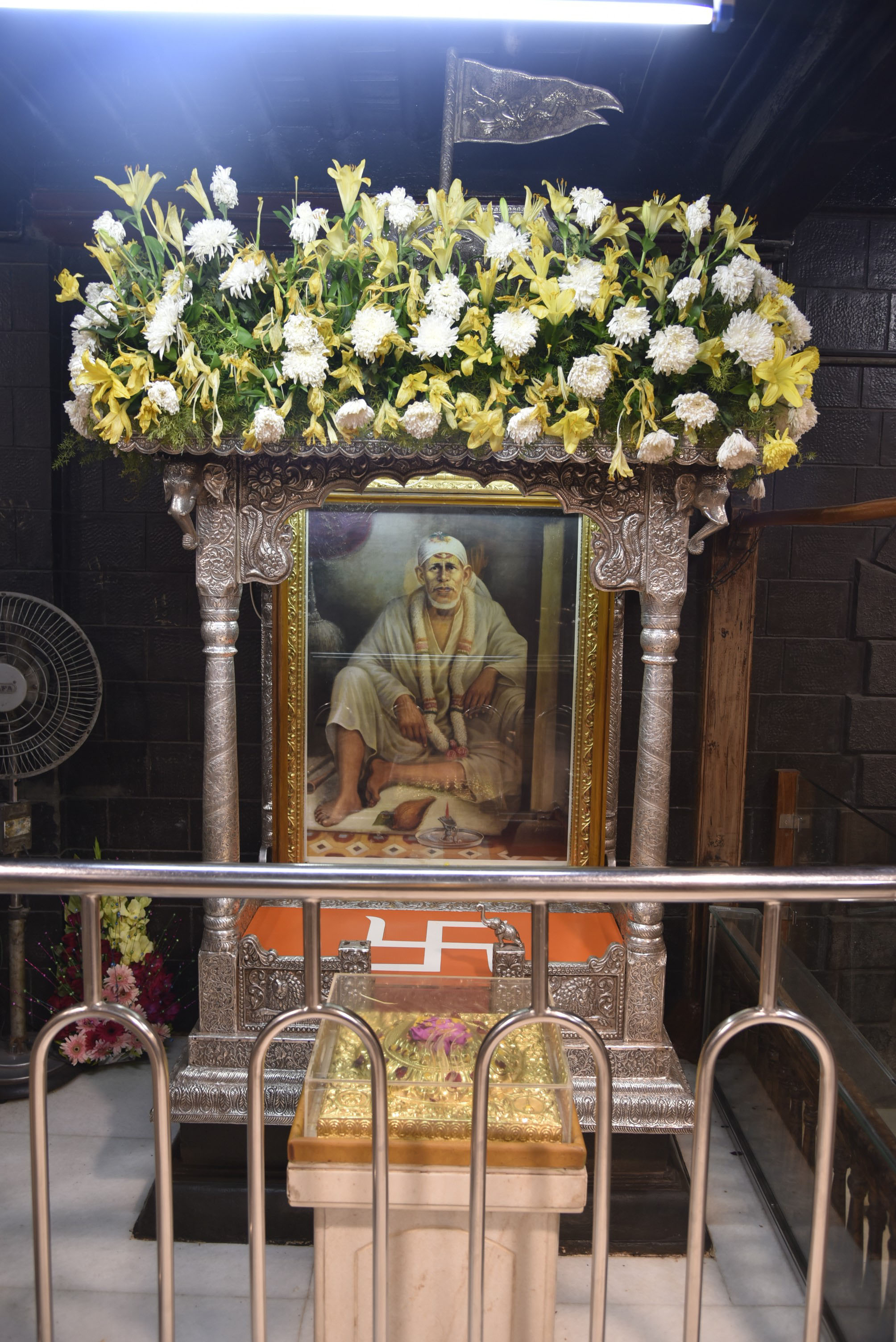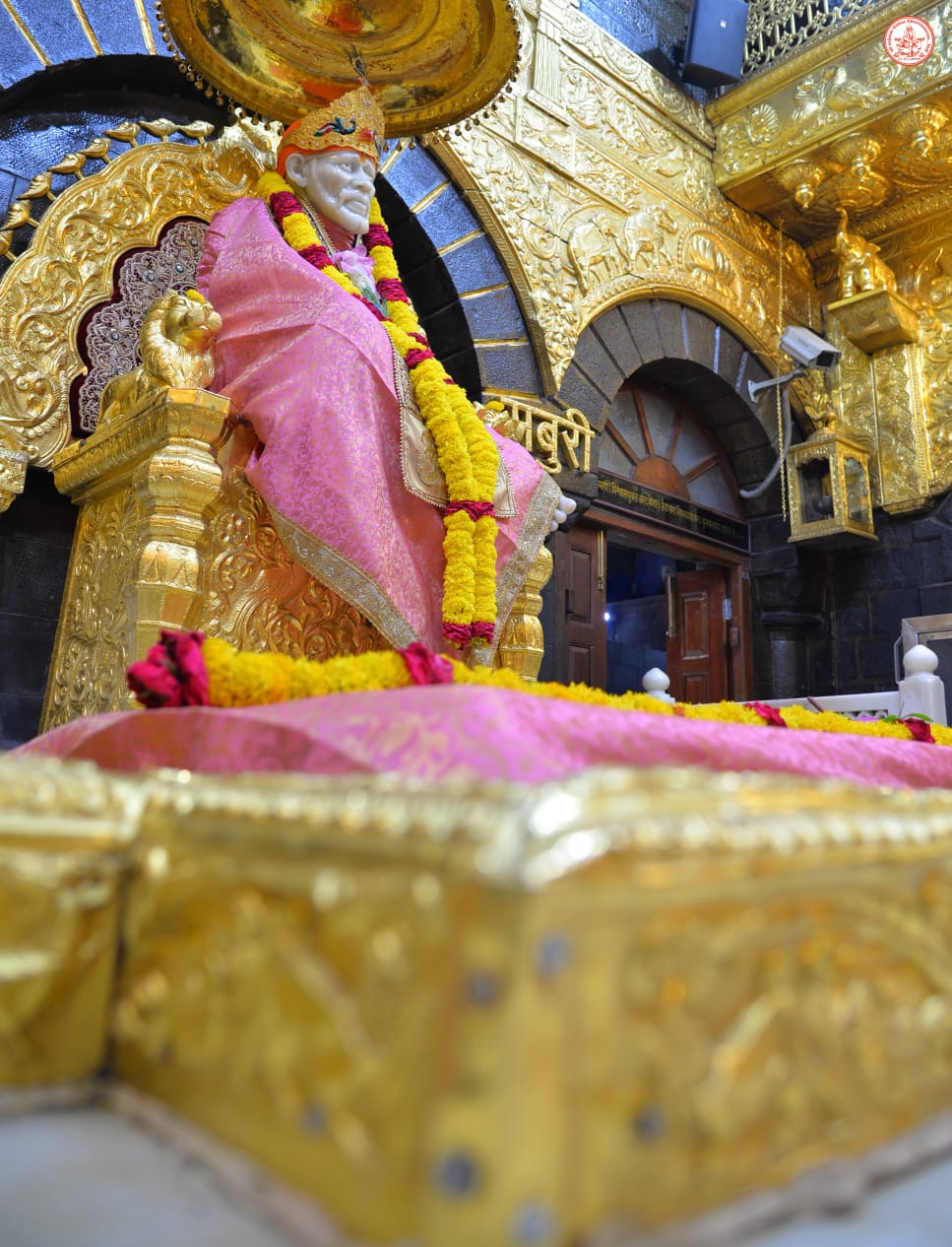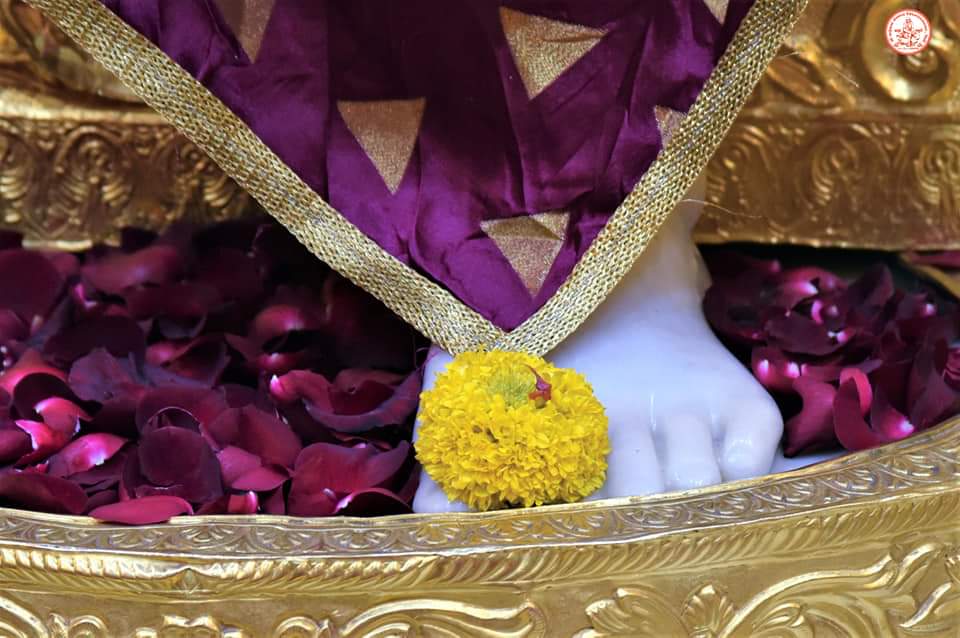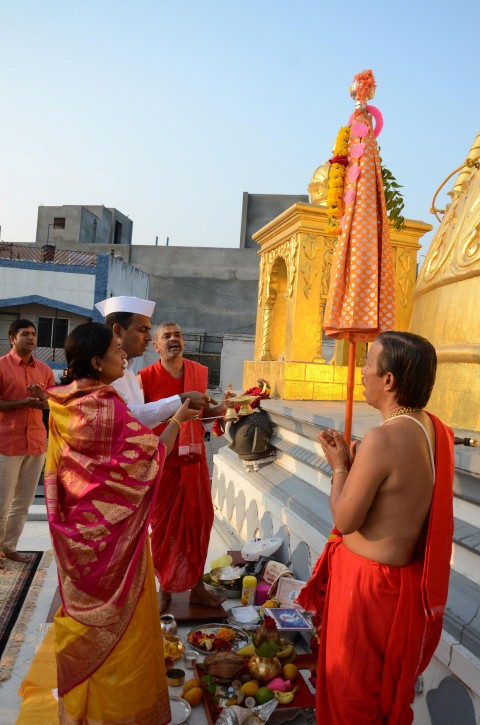They are three Major festivals that are celebrated in shirdi in grand manner.
Festivals Celebrated in Shirdi
They are three Major festivals celebrated in shirdi in grand manner.
Origin
One, Mr. Gopalrao Gund, was a Circle Inspector at Kopergaon. He was a great devotee of Baba. He had three wives, but had no issue. With Sai Baba’s blessings, a son was born to him. In the joy that he felt regarding the event, an idea of celebrating a fair or ‘Urus’ occurred to him in the year 1897, and he placed it for consideration before other Shirdi devotees, viz. Tatya Patil, Dada Kote Patil and Madhavrao Deshpande (Shama). They all approved of the idea, and got Sai Baba’s permission and blessings. Then an application for getting the Collector’s sanction for celebrating the urus was made, but as the village Kulkarni reported against holding the fair, the sanction was refused. But as Sai Baba had blessed it, they tried again, and ultimately succeeded in getting the Collector’s sanction. The day for the Urus was fixed on the Rama-Navami day, after having consultation with Sai Baba. It seems, He had some end in view, in this, viz., the Unification of the two fairs of festivals, the Urus and the Rama-Navami and the unification of the two communities - the Hindus and the Mahomedans. As future events showed, this end or object was achieved.
Though the permission was obtained, but other difficulties cropped up. Shirdi was a village, and there was scarcity of water. There were two wells in the village, the one in use, dried up soon, and the water from the second was brackish. This brackish water was turned into sweet one by Sai Baba, by throwing flowers into it. The water of this well was insufficient, so Tatya Patil had to arrange to get water, from a well by fixing Moats (leather sacks) thereon, at a considerable distance. Then temporary shops had to be constructed, and wrestling bouts arranged. Gopalrao Gund had a friend, by name Damu Anna Kasar, of Ahmednagar. He also was similarly unhappy in the matter of progeny, though he married two wives. Sai Baba too blessed him with sons, and Mr. Gund prevailed upon his friend to prepare and supply one simple flag for the procession of the fair; he also succeeded in inducing Mr. Nanasaheb Nimonkar to supply another embroidered flag. Both these flags were taken in procession through the village, and finally fixed at the two ends or corners of the Masjid, which is called by Sai Baba as Dwarkamai. This is being done even now.
Sree Rama Rama Rameti Rame Rame Manorame, Sahasranama Tattulyam Rama Nama Varanane
Sree Rama Jaya Rama Jaya Jaya Rama
Rama Lakshmana Janaki Jai Bolo Hanuman Ki
Hare rama hare rama rama rama hare hare hare krishna hare krishna krishna hare hare
The ‘Sandal’ Procession
There was another procession, which was started in this fair. This idea of ‘Sandal’ procession originated with one Mr. Amir Shakkar Dalal, a Mahomedan Bhakta from Korhla. This procession is held in honour of great Muslim Saints. Sandal i.e. Chandan paste and scrappings are put in the THALI (flat dishes), and these are carried with incense burning before them in procession to the accompaniment of band and music through the village and then after returning to the Masjid, the contents of the dishes are thrown on the ‘Nimbar’ (nitche) and walls of the Masjid with hands. This work was managed by Mr. Amir Shakkar for the first three years, and then afterwards by his wife. So on one day, the two processions, the ‘Flags’ by the Hindus and that of ‘Sandal’ by the Muslims, went on side by side, and are still going on without any hitch.
Arrangement
This day was very dear and sacred to the devotees of Sai Baba. Most of them turned out on the occasion, and took a leading part in the management of the fair. Tatya Kote Patil looked to all outward affairs, while the internal management was entirely left to one Radha Krishna Mai, a female devotee of Baba. Her residence was full of guests on the occasion, and she had to look to their needs, and also to arrange for all the paraphernalia of the fair. Another work, which she willingly did, was to wash out and clean and white-wash the entire Masjid, its walls and floor, which were blackened and were full of soot on account of the ever-burning Dhuni (sacred fire) of Sai Baba. This work, she did during the night, when Sai Baba went to sleep every alternate day in the Chavadi. She had to take out all the things, including even the Dhuni, and after thorough cleaning and whitewashing replace them, as they were before. Feeding the poor, which was so dear to Sai Baba, was also a great item in this fair. For this purpose, cooking, on a grand scale and preparing various sweet dishes, was done in Radha-Krishna Mai’s lodging, and, various rich and wealthy devotees took a leading part in this affair.
Transformation of Urus into Rama-Navami Festival
Things were going on in this way and the fair was gradually increasing in importance till 1912 A.D., when a change took place; That year one devotee, Mr. Krishnarao Jageshwar Bhisma (the author of the pamphlet ‘Sai Sagunopasana’), came for the fair with Dadasaheb Khaparde of Amraoti, and was staying on the previous day in the Dixit Wada. While he was lying on the verandah, and while Mr. Laxmanrao alias Kaka Mahajani, was going down with Puja materials to the Masjid, a new thought arose in his mind and he accosted the latter thus - There is some providential arrangement in the fact that the Urus or fair is celebrated in Shirdi on the Rama-Navami day; this day is very dear to all the Hindus; then why not begin the Rama-Navami Festival - the celebration of the birth of Shri Rama here on this day? Kaka Mahajani liked the idea, and it was arranged to get Baba’s permission in this matter. The main difficulty was how to secure a Haridas, who would perform ‘Kirtan’ and sing the glories of the Lord on the occasion. But Bhishma solved the difficulty, by saying that his ‘Rama Akhyan’ (composition on Rama’s birth) was ready, and he would do the ‘Kirtan’ himself, while Kaka Mahajani should play on the harmonium.
It was also arranged to get the ‘Sunthavada’ (ginger-powder mixed with sugar) as Prasad prepared by Radha-Krishna Mai. So they immediately went to the Masjid to get Baba’s permission. Baba, who knew all things and what was passing there, asked Mahajani, as to what was going on in the Wada. Being rather perturbed, Mahajani could not catch the purport of the question and remained silent. Then Baba asked Bhishma, what he had to say. He explained the idea of celebrating Rama-Navami festival, and asked for Baba’s permission and Baba gladly gave it. All rejoiced and made preparations for the Jayanti-festival. Next day, the Masjid was decorated with buntings etc., a cradle was supplied by Radha-Krishna Mai, and placed in front of Baba’s seat and the proceedings started. Bhishma stood up for Kirtan and Mahajani played on the harmonium.
Sai Baba sent a man to call Mahajani. He was hesitating to go, doubting whether Baba would allow the festival to go on; but when he went to Baba, the latter asked him as to what was going on and why the cradle was placed there. He answered that the Rama-Navami festival had commenced, and the cradle was put on for that purpose. Then Baba took a garland from the ‘Nimbar’ (nitche), and placed it round his neck and sent another garland for Bhishma. Then commenced the Kirtan. When it came to a close, pound sounds of "Victory to Rama" went up; and Gulal (red - powder) was thrown up all round, amidst band and music. Everybody was overjoyed, when suddenly roaring was heard. The red-powder thrown promiscuously all round, went up, somehow entered Baba’s eyes. Baba got wild and began to scold and abuse loudly. People got frightened by this scene and took to their heels. Those intimate devotees, who knew Baba well, took these scoldings and outpourings of Baba, as blessings in disguise. They thought that when Rama was born, it was proper for Baba to get wild and enraged to kill Ravana; and his demons, in the form of egoism and wicked thoughts etc. Besides they knew, that whenever a new thing was undertaken at Shirdi, it was usual with Baba to get wild and angry, and so they kept quiet. Radha-Krishna Mai was rather afraid; and thought that Baba might break her cradle, and she asked Mahajani to get the cradle back.
When he went to loosen and unfasten the cradle, Baba went to him, and asked him not to remove it. Then after some time, Baba became calm, and that day’s programme, including Mahapuja and Arati was finished. Later on, Mr. Mahajani asked Baba, for permission to remove the cradle, Baba refused the same saying, that the festival was not yet finished. Next day, another ‘Kirtan’ and Gopal-Kala ceremony (an earthern pot containing parched rice mixed with curds is hung, only to be broken after the ‘Kirtan’, and the contents distributed to all, as was done by Lord Krishna amongst His cow-herd (friends), were performed, and then Baba allowed the cradle to be removed. While the Rama-Navami festival was thus going on, the procession, of the two flags by day and that of the ‘Sandal’ by night, went off with the usual pomp and show. From this time onwards, the ‘Urus of Baba’ was transformed into the Rama-Navami festival.
From next year (1913), the items in the programme of Rama-Navami began to increase. Radha-Krishna Mai started a ‘Nama-Saptah’ (singing the glory of God’s name continuously day and night for seven days), from 1st of Chaitra, For this, all devotees took part by turns, and she also joined it, sometimes early in the morning. As Rama-Navami Festival is celebrated in many places all over the country, the difficulty of getting a Haridas was felt again. But 5 or 6 days before the festival, Mahajani met accidentally Balabuva Mali, who was known as modern Tukaram, and got him to do the ‘Kirtan’ that year. The next year (1914), another Balabuva Satarkar of Brihadsiddha Kavate, District Satara, could not act as a Haridas in his own town, as plague was prevailing in his town, and so he came to Shirdi; With Baba’s permission, which was secured through Kakasaheb Dixit, he did the Kirtan; and was sufficiently recompensed for his labour. The difficulty of getting a new Haridas every year was finally solved from 1914 by Sai Baba, as He entrusted this function to Das Ganu Maharaj permanently, and since that time, he has been successfully and creditably conducting that function uptill now.
Since 1912, this festival began to grow gradually year-by-year. From the 8th to 12th of Chaitra, Shirdi looked like a beehive of men. Shops began to increase. Celebrated wrestlers took part in wrestling bouts. Feeding of the poor was done on a grander scale. Hard work and sincere efforts of Radha-Krishna Mai turned Shirdi into a Sansthan (State). Paraphernalia increased. A beautiful horse, a palanquin, chariot and many silver things, pots, buckets, pictures, mirrors etc. were presented. Elephants were also sent for the procession. Though all this paraphernalia increased enormously, Sai Baba ignored all these things, and maintained His simplicity as before. It is to be noted that both the Hindus and Mahomedans have been working in unison in both the processions, and during the entire festival, there has been no hitch or quarrel between them at all so far. First about 5000-7000 people used to collect, but that figure went up to 75000 in some years; still there was no outbreak of any epidemic or any riots worth the name during so many past years.
Repairs to the Masjid
Another important idea occured to Gopal Gund. Just as he started the Urus or fair, he thought that he should put the Masjid in order. So in order to carry out the repairs, he collected stones and got them dressed. But this work was not assigned to him. This was reserved for Nanasaheb Chandorkar, and the pavement -work for Kakasaheb Dixit. First, Baba was unwilling to allow them to have these works done, but with the intervention of Mahalsapati, a local devotee of Baba, His permission was secured. When the pavement was completed in one night in the Masjid, Baba took a small Gadi for His seat, discarding the usual piece of sack - cloth used till then. In 1911, the Sabha - Mandap (court - yard) was also put in order with great labour and effort. The open space in front of the Masjid was very small and inconvenient.
Kakasaheb Dixit wanted to extend it and put on it roofing. At great expense, he got iron-posts, and pillars and trusses and started the work. At night, all the devotees worked hard and fixed the posts; but Baba, when he returned from Chavadi next morning, uprooted them all and threw them out. Once it so happened that Baba got very excited, caught a pole with one hand, and began to shake and uproot it, and with the other hand caught the neck of Tatya Patil. He took by force Tatya’s Pheta, struck a match, set it on fire and threw it in a pit. At that time, Baba’s eyes flashed like burning embers. None dared to look at Him. All got terribly frightened. Baba took out a rupee from his pocket and threw it there, as if it were an offering on an auspicious occasion. Tatya also was much frightened. None knew what was going to happen to Tatya, and none dared to interfere.
Bhagoji Shinde, the leper devotee of Baba, made a little boldly advance, but he was pushed out by Baba. Madhavrao was also similarly treated, he being pelted with brick pieces. So all those, who went to intercede, were similarly dealt with. But after some time, Baba’s anger cooled down. He sent for a shopkeeper, got from him an embroidered Pheta and Himself tied it on Tatya’s head, as if he was being given a special honour. All the people were wonderstruck to see this strange behavior of Baba. They were at a loss to know, what enraged Baba so suddenly and what led Him to assault Tatya Patil, and why His anger cooled down, the next moment. Baba was sometimes very calm and quiet and talked sweet things with love, but soon after, with or without any pretext, got enraged. Many such incidents may be related; but I do not know which to choose and which to omit. I, therefore, refer them as they occur to me.
Bow to Shri Sai Baba - Peace be to all
More info about Ramnavami festival: Ramanavami, the Festival of Rama’s Birth
On Chaitra Masa Shukla Paksha Navami (March-April 9th Day as per the Hindu Almanac) Ramanavami is celebrated. It was in 1911 that Ramanavami was first celebrated in Shirdi. The idea originated from the Urs. It was K.G. Bhishma who conceived of this idea and consulted Kaka Mahajani who liked the idea and readily agreed. Both of them went to Baba and sought permission, Baba gave His consent. Since then Ramanavami is celebrated on a grand scale. It is a three day festival.
On the first day, there is Akhand Parayan (continuous reading) of Shri Sai Satcharitra. The devotees can submit their names a day before the festival. In the evening a child is asked to pick up the chits by lottery. Fifty three names are thus chosen and the chapters are assigned, and five names are chosen as standby. After the Dhoop Aarti, these names are announced, and lists are posted at various places. This procedure is followed for all the three major festivals.
After Kakad Aarti, the Akhand Parayan commences. The Pothi is brought in procession from the Samadhi Mandir. The procession consists of a devotee (usually a trustee) who carries the sacred Pothi. Alongside him another devotee carries a Veena (a stringed musical instrument). The Veena is symbolic of Saraswati’s Brahma-Veena. Another devotee carries the portrait of Baba. The Kirtankar (who is also the Pujari) sings all the way from the Samadhi Mandir to the Dwarakamai.
The procession commences with Mantra Upachar, Laghu Aarti and Lalkari. The procession comes out of the Samadhi Mandir through the South Gate. Paad Pooja (washing the feet) and Aarti of Camphor are performed by the Iyer family who reside in Shirdi. The procession then goes to the Gurusthan where again Mantra Upachar, Laghu Aarti and Lalkari is performed. The procession then turns right and in front of Dixit Wada Paad Pooja is performed by the Sansthan. It then proceeds through the Maha Dwar past the Maruti Mandir to the Dwarakamai. This entourage is followed by numerous devotees.
In the Dwarakamai the area in the verandah next to the railing is decorated with banana trees. A silver shrine is kept to welcome Baba’s portrait and the Pothi. A Laghu Aarti is performed to Baba and the Pothi, then the reading commences. The Dwarakamai is open through the night. Late in the evening there is Palkhi Procession.
The second day is the Main Utsav (festival) Day. There is Kakad Aarti. Then after the completion of the Akhand Parayan, the Pothi is taken in procession to the Samadhi Mandir.
There is Mantra Upachar, Laghu Aarti and Lalkari. The Pothi is then taken in procession. It exits the Dwarakamai and passes by the rear of the Samadhi Mandir and enters the Gurusthan where a Laghu Aarti is performed. The entourage then goes towards the main Dwar of the Samadhi Mandir. Just before entering the Samadhi Mandir, Paad Puja is performed to the bearers of the sacred articles by the Sansthan. They then enter the Samadhi Mandir. Thus the entourage would have completed the Pradakshina of the previous day.
In the Samadhi Mandir there is Mangal Snan (holy bath of Baba’s Idol). The villagers and numerous devotees go to the Godavari (Kopergaon) and bring water from Godavari for Baba's Holy Bath. Water is also brought from the Ganga and other holy rivers by many zealous devotees. The “Kavadis” (water bearers) are allowed to wash Baba’s Samadhi and Baba's Padukas with the holy water.
At about 8 a.m. the changing the sack of Wheat takes place. A new sack of Wheat is brought in procession from the Samadhi Mandir to Dwarakamai. The old sack is taken to Prasadalay and the new sack is placed in the cupboard. This tradition was started by Balaji Newaskar. Now the Sansthan performs this ceremony.
At 12 Noon is the birth of Rama. A cradle is placed in Samadhi Mandir signifying Rama's Birth. Radhakrishna Mai gave a cradle when the first time Ramanavami was celebrated in Shirdi and the tradition continues. Now the Sansthan performs this ceremony. Following this ceremony there is the noon Aarti. Between 2 p.m. and 4 p.m., the Changing of the Flags takes place. This is described in the Shri Sai Satcharitra Chapter 6 in detail.
Every year two new flags were taken out in procession. Since then this ceremony is performed. The descendants of Damu Anna Rasne supply the embroidered flag, while Nimonkar’s descendants supply the green flag. These flags are kept on Baba’s Samadhi and Aarti is performed to them. Then the Noon Aarti takes place. They are taken to Tukaram Sutar’s house (his surname is Bhalerao and his profession was that of a Sutar or Carpenter). At about 2 p.m.the gheru flags are brought in a procession from Samadhi Mandir to the open area in front of Pilaji Gurav's house. Then the other two flags (The green and embroidered flags) are brought from the Sutar home where they were fixed to a long staff (pole). After Lalkari Laghu Aarti is done. Then all the flags are taken in procession through the village with much dancing and merriment to Dwarakamai. Finally, the two flags (gheru flags – Green and embroidered flags) are fixed atop the Dwarakamai, while the Ochere flag is fixed inside the Dwarakamai.
The Urs and Sandal Procession
In 1897 Gopalrao Gund wanted to honor Baba with a special festival, thus the Urs was started. Urs literally means a wedding with God or uniting the soul with God at death. It is an annual celebration, and the saint’s spiritual power is at its peak at that time.
Between 9 p.m. and 10 p.m. the “Sandal Procession” takes place. The descendants of Abdul Baba perform this. It is a beautiful ceremony. A platter with sandalwood scrapings along with incense is taken in procession around the village to the accompaniment of musical instruments. The platter, the incense and gifts to be offered are carried under a canopy. This canopy consists of a “Gailif” or “Chaddar” that is attached to four wooden posts. The Gailif is green in color with golden Kalmas (Kalmas are verses from the holy Quran) inscribed on it. On top of every post is a Panja (a silver replica of a hand). This sandal procession is to venerate Auhlias (Muslim Saints). It is described in chapter 6 of Shri Sai Satcharitra. At the Samadhi Mandir, gifts like a Chaddar (Shawl), fruits and sweets are offered. The procession then goes to Abdul Baba’s Darga and again gifts are offered. The procession ends in the Dwarakamai, where sandalwood mixed with rose water and Attar (a type of perfume) is pasted on the Nimbar with bare hands.
In the Evening there is the Rath Procession. The whole right there is Bhajan Sandhya by various invited artists in the Samadhi Mandir. Thousands of devotees participate in this programme and it joyfully goes on till the wee hours of the next day. There is no Shej Arati as Samadhi Mandir is kept open for whole night for Darshan.
The next morning i.e., on the third day, there is no Kakad Aarti. Till 12 Noon there is Kaala Kirtan and then the Gopal Kaala is done. This ceremony is celebrated with joy, merriment and feasting at the end of the festival. A Handi (earthen pot) filled with the ingredients (mixture of curds, Lye- puffed Jvari grain, turmeric powder, cumin seeds, coriander seeds and honey) is hung up and is broken and the contents are distributed. At the auspicious time it is broken and the contents are distributed as Prasad.
Relation between Saibaba and Rama Navami Festival
Saibaba celebrated Rama Navami festival right from the early days of his stay in the Dwarakamai. On that day he washed the entire Dwarakamai himself. At about 12 noon he bought a little oil and lit a few lamps. From the rest of the money he bought some Gulal (a dry vermilion powder). Having done this he first put some on the Dhuni Maa and then on his own head. Then he put some on each of the steps leading to the Dwarakamai and in every corner and finally applied some to the entrance door. Later when the devotees started flocking to Shirdi they had Katha and Kirtan in the Sabhamandap followed by the birth of Rama, following which Baba distributed Pedas and Burfi (sweets). (Refer Shiladhi written by Dr.Keshav B.Gavankar).
Pooja of the Sadguru or Guru Poornima is the greatest festival celebrated at Shirdi, Gurupoornima ("poornima" means full moon) is the day on which disciples and devotees honour and felicitate their guru and seek his or her special blessings. Although it is not a major festival for everyone in India, it is of great importance in Shirdi, being the only festival which Baba asked devotees to celebrate. It falls on the full moon day of the month of Ashad in the Hindu calendar (June-July). The festival originated in the Buddha's time when the monks used to take diksha (instructions on their spiritual practice) at the beginning of the annual four-month rains-retreat. The practice was then borrowed by the Jain tradition and later by the Hindus.
Efficacy of the Touch of Guru’s Hand
Where Real or Sadguru is the helmsman, he is sure to carry us safely and easily beyond the worldly ocean. The word Sadguru brings to mind Sai Baba. He appears to me, as if standing before me, and applying Udi (scared ashes) to my forehead and placing his hand of blessing on my head. Then joy fills my heart and love overflows through my eyes. Wonderful is the power of the touch of Guru’s hand. The subtle-body (consisting of thoughts and desires), which cannot be burnt by the world dissolving fire, is destroyed by the mere touch of the Guru’s hand, and the sins of many past births are cleaned and washed away. Even the speech of those, whose heads feel annoyed when they hear religious and Godly talks, attains calmness. The seeing of Sai Baba’s handsome form, chokes our throat with joy, makes the eyes overflowing with tears, and overwhelms the heart with emotions. It awakens in us ‘I am He (Brahman)’ consciousness, manifests the joy of self-realization, and dissolving the distinction of Thou, and I then and there, makes us one with the Supreme (One Reality).
When I begin to read scriptures, at every step I am reminded of my Sadguru, and Sai Baba, assumes the form of Rama or Krishna and makes me listen to his Life. For instance when I sit to listen to Bhagwat, Sai becomes Krishna from top to toe, and I think he sings the Bhagwat or Uddhava Gita (song of teachings by Lord Shri Krishna to His disciple, Uddhava) for the welfare of the devotees. When I begin to chitchat, I am at once put in mind of Sai’s stories for enabling me to give suitable illustrations. When I myself start to write anything, I cannot compose a few words or sentences, but when He of his own accord makes me write, I go on writing and writing and there is no end to it. When the disciple’s egoism props up, He presses it down with His hand, and giving him His own power, makes him gain His object, and thus satisfies and blesses him.
If any one prostrates before Sai and surrenders heart and soul to Him, then unsolicited, all the chief objects of life viz. Dharma (righteousness), Artha (wealth), Kama (Desire) and Moksha (Deliverance), are easily and unsolicitedly attained. Four paths, viz., of Karma, Jnana, Yoga and Bhakti lead us separately to God. Of these, the path of Bhakti is thorny and full of pits and ditches, and thus difficult to traverse, but if you, relying on your Sadguru, avoid the pits and thorns and walk straight, it will take you to the destination (God). So says definitely, Sai Baba.
After philosophising about the Self-Existent Brahman, His Power (Maya) to create this world and the world created, and stating that all these three are ultimately one and the same, the author quotes Sai Baba’s words guaranteeing the welfare of the Bhaktas: -
"There will never be any dearth or scarcity, regarding food and clothes, in any devotees’ homes. It is my special characteristic, that I always look to, and provide, for the welfare of those devotees, who worship Me whole-heartedly with their minds ever fixed on Me. Lord Krishna has also said the same in the Gita. Therefore, strive not much for food and clothes. If you want anything, beg of the Lord, leave worldly honours, try to get Lord’s grace and blessings, and be honored in His Court. Do not be deluded by worldly honor. The form of the Deity should be firmly fixed in the mind. Let all the senses and mind be ever devoted to the worship of the Lord, let there be no attraction for any other thing; fix the mind in remembering Me always, so that it will not wander elsewhere, towards body, wealth and home. Then it will be calm, peaceful and carefree. This is the sign of the mind, being well engaged in good company. If the mind is vagrant, it cannot be called well-merged."
After quoting these words, the author goes on to relate the story of Rama Navami festival in Shirdi. As Rama-Navami is the greatest festival celebrated at Shirdi, another fuller account, as published in Sai Leela Magazine of 1925, page 197, is also referred to and a summary of the festival, as related in both these accounts is attempted here.
Saibaba accepted Dakshina and Namaskar (prostrating at his feet) from his devotees. Yet he actively discouraged and forbade ritualistic pooja directed towards him. Instead he asked them to perform pooja to the pillar in front of the Dhuni Maa. Baba sat for hours in front of this pillar leaning his back against it. When the devotees went to the Dwarakamai at about 5 a.m. they found Baba sitting there gazing into the Dhuni Maa.
In the year 1908, Tatya Saheb Nulkar, who was a subjudge in Pandarpur, came to stay in Shirdi. Baba asked him to stay in the Chavadi. One day, in the morning Baba told Shama, “Ask Mhatara (old man) to perform pooja to the pillar”. Shama went and told Nulkar (Mhatara) exactly what Baba had said. Both of them discussed the reason for this, but could not come up with an answer. At last they consulted the almanac, and found that it was Vyas Poornima or Guru Poornima Day. But Baba had asked him to perform Pooja to the pillar, and not to him.
According to H. V. Sathe, Gurupoornima celebrations in Shirdi
were started one year when Baba called Dada Kelkar (probably in 1910)
and said, "Don't you remember that this is Gurupoornima? Come on,
go and worship that post there." That post is in the mosque.
Later Dada Kelkar told others, and so everybody thought that
Baba gave importance to Gurupoornima; thus the tradition started.
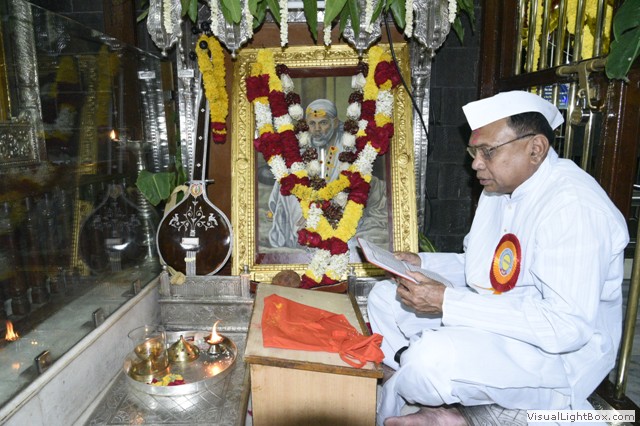
Guru Poornima is celebrated in the Ashad Masa (June-July).
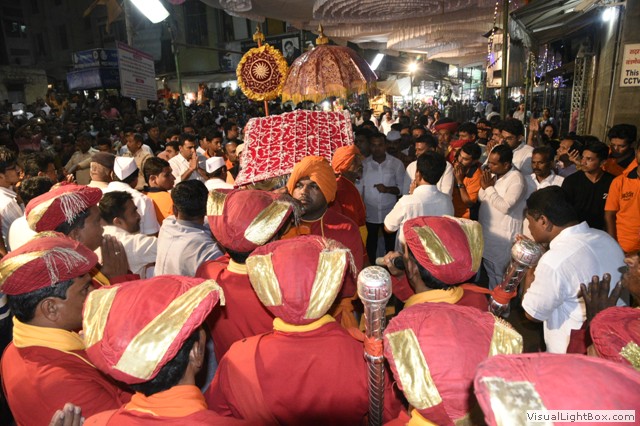
First Day: Akhand Parayan. Palki procession through the village Dwarakamai is kept open the whole night.
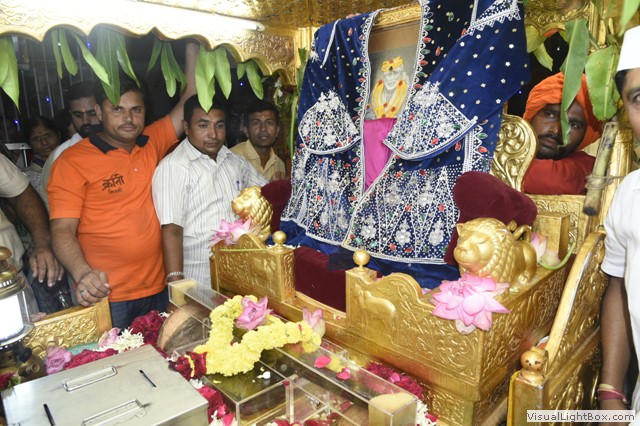
Second Day: Is the main Utsav with Rath procession through the village. There is no Shej Arati as the Samadhi Mandir is open throughout the whole night for Darshan.
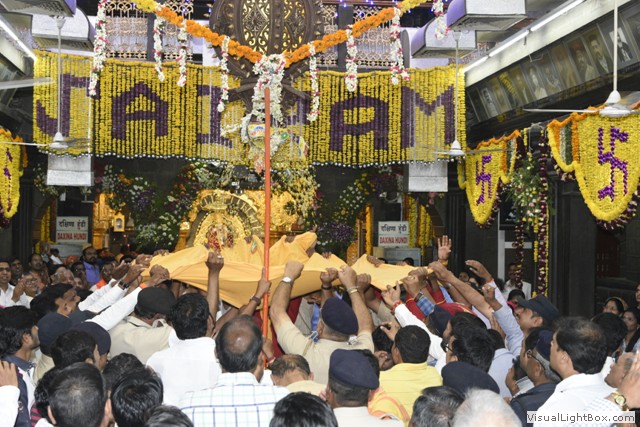
Third day gopal kaala will be celebrated
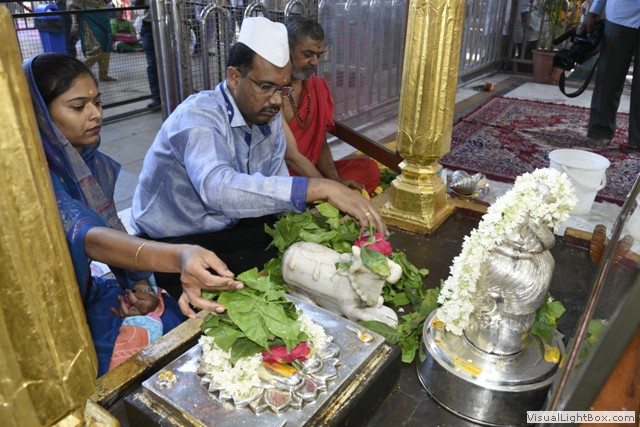
As well rudrabhisheka at gurustan
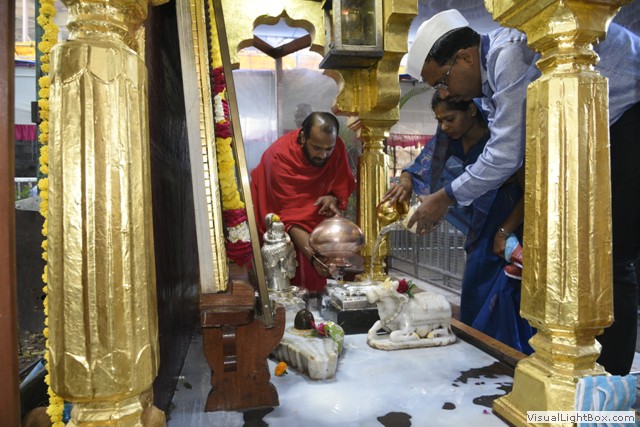
Priests will perform rudrabhisheka at the gutustan
Nonetheless they were very happy that at least he had allowed pooja to be performed in the Dwarakamai. Nulkar was performing pooja to the pillar when Shama turned up. Baba said “Why is he performing pooja all by himself? Why can’t you too perform the pooja? Shama replied “I will not perform pooja to this pillar. But if you will allow me to perform pooja to you, I will gladly do so. I will only worship you and not this or any other pillar”. After a lot of debate and discussion, Baba finally agreed.
Dada Kelkar was aware that it was Guru Poornima, so he sent for Tatya who had gone to his farm. Both of them went with pooja materials, and performed Guru Pooja. The rest of the devotees followed suite. They offered fruits, dakshina and vastra (dhotis) to their Guru. The dhoti was of no use to Baba but they got the opportunity to do Guru Pooja that day and they hoped it would continue in the future.
Thus the festival of Guru Poornima which was first started on 13th July 1908 (Monday). Now it is a three day function. On the first day there is Akhand Parayan, the second day is the main festival day and it concludes on the third day with Gopal Kaala. (Refer Shiladhi written by Dr.Keshav B.Gavankar).
Vijayadasami is a major festival celebrated throughout India under different names and with regional variations, as the victory of good over evil. It is also known as Dusserah and is the culmination of the nine days of goddess worship., For Sai devotees, it is venerated as the holy day that their beloved gurudeva attained mahasamadhi (also known as punyatithi) and is a big festival in Shirdi. This was also the day on which the statue of Baba "came to life" and was inaugurated in the Samadhi Mandir. For devotees of Sri Sainathuni Sarath Babuji it is a day imbued with additional significance and joy as it is the same day he took birth in 1954.
Vijayadasami is a major festival celebrated throughout India under different names and with regional variations, as the victory of good over evil. It is also known as Dusserah and is the culmination of the nine days of goddess worship., For Sai devotees, it is venerated as the holy day that their beloved gurudeva attained mahasamadhi (also known as punyatithi) and is a big festival in Shirdi. This was also the day on which the statue of Baba "came to life" and was inaugurated in the Samadhi Mandir. For devotees of Sri Sainathuni Sarath Babuji it is a day imbued with additional significance and joy as it is the same day he took birth in 1954.
Sai' devotees now hear attentively Baba's Passing away. Baba got a slight attack of fever on 28th September, 1918. The fever lasted for 2 or 3 days, but afterwards Baba gave up his food and thereby He grew weaker and weaker. On the 17th day, i.e., Tuesday, the 15th October 1918, Baba left His mortal coil at about 2-30 p.m. (Vide Professor G.G. Narke's letter, dated 5th November 1918, to Dadasaheb Khaparde, published in "Sai Leela" magazine, Page 78, first year).
Two years before this, i.e., in 1916, Baba gave an indication of His Passing away, but nobody understood it then. It was as follows:- On the Vijayadashmi (Dasara) day Baba at once got into wild rage in the evening when people were returning from 'Seemollanghan' (crossing the border or limits of the village). Taking off His head-dress, kafni and langota etc., He tore them and threw them in the Dhuni before Him. Fed by this offering, the fire in the Dhuni began to burn brighter and Baba shone still brighter. He stood there stark naked and with His burning red eyes shouted - "You fellows, now have a look and decide finally whether Iam a Moslem or a Hindu." Everybody was trembling with fear and none dared to approach Baba.
After some time Bhagoji Shinde, the leper devotee of Baba, went boldly near Him and succeeded in tying a langota (waist-band) round His waist and said - "Baba, what is all this? To-day is the Seemollanghan, i.e., Dasara Holiday." Baba striking the ground with His satka said - "This is my Seemollanghan (crossing the border)." Baba did not cool down till 11-00 p.m. and the people doubted whether the chavadi procession would ever take place that night. After an hour Baba resumed His normal condition and dressing Himself as usual attended the chavadi procession as described before. By this incident Baba gave a suggestion that Dasara was the proper time for Him to cross the border of life, but none understood its meaning. Baba gave also another indication as follows:-
Averting Death of Ramachandra and Tatya Patil
Some time after this, Ramachandra Patil became scriously ill. He suffered a lot. He tried all remedies, but finding no relief, despaired of his life and was waiting for the last moment. The one midnight Baba suddenly stood near his pillow. Patil held His Feet and said - "I have lost all hopes of life, please tell me definitely when I shall die." Merciful Baba said - "Don't be anxious, your hundi (death-warrant) has been withdrawn and you will soon recover, but Iam afraid of Tatya Patil. He will pass away on Vijayadashami of Shaka 1840 (1918 A.D.).
Do not divulge this to anybody, nor to him, for he will be terribly frightened." Ramachandra Dada got well, but he felt nervous about Tatya's life, for he knew that Baba's word was unalterable, and that Tatya would breathe his last within two years. He kept this hint secret, told it to none but one Bala Shimpi (a tailor). Only these two persons - Ramachandra Dada and Bala Shimpi were in fear and suspense regarding Tatya's life.
Ramachandra Dada soon left his bed and was on his legs. Time passed quickly. The month of Bhadrapad of Shaka 1840 (1918 A.D.) was ending and Ashwin was in sight. True to Baba's word, Tatya fell sick and was bed-ridden; and so he could not come for Baba's darshana. Baba was also down with fever. Tatya had full faith in Baba and Baba in Lord Hari, who was His Protector. Tatya's illness began to grow from bad to worse and he could not move at all but always remembered Baba. The predicament of Baba began to grow equally worse.
The day predicted, i.e., Vijayadashami was impending and both Ramachandra Dada and Bala Shimpi were terribly frightened about Tatya and with their bodies trembling and perspiring with fear, thought that as predicted by Baba, Tatya's end was nigh. Vijayadashami dawned and Tatya's pulse began to beat very slow and he was expected to pass away shortly. But a curious thing happened. Tatya remained, his death was averted and Baba passed away in his stead. It seemed as if there was an exchange. People said that Baba gave up His life for Tatya; why He did so? He alone knows as His ways are inscrutable. It seems, however, that in this incident, Baba gave a hint of His passing away, substituting Tatya's name for His.
Next morning (16th October) Baba appeared to Das Ganu at Pandharpur in his dream and said to him - "The Masjid collapsed, all the oilmen and grocers of Shirdi teased me a lot, so I leave the place. I therefore came to inform you here, please go there quickly and cover me with 'Bhakkal' flowers." Das Ganu got the information also from Shirdi letters. So he came to Shirdi with his disciples and started bhajan and kirtan and sang the Lord's name, all through the day before Baba's samadhi. Himself weaving a beautiful garland of flowers studded with Lord Hari's name he placed it on Baba's samadhi and gave a mass-feeding in Baba's name.
Charity to Laxmibai
Dasara or Vijayadashami is regarded by all the Hindus as the most auspicious time and it is befitting that Baba should choose this time for His crossing the border-line. He was ailing some days before this, but He was ever conscious internally. Just before the last movement He sat up erect without anybody's aid, and looked better. People thought that the danger had passed off and He was geeting well. He knew that He was to pass away soon and therefore, He wanted to give some money as charity to Laxmibai Shinde.
Baba Pervading All Creatures
This Laxmibai Shinde was a good and well-to-do woman. She was working in the Masjid day and night. Except Bhagat Mhalasapati, Tatya and Laxmibai, none was allowed to step in the Masjid at night. Once while Baba was sitting in the Masjid with Tatya in the evening, Laxmibai came and saluted Baba. The latter said to her - "Oh Laxmi, Iam very hungry." Off she went saying - "Baba, wait a bit, I return immediately with bread." She did return with bread and vegetables and placed the same before Baba. He took it up and gave it to a dog.
Laxmibai then asked - "What is this, Baba, I ran in haste, prepared bread with my own hands for You and You threw it to a dog without eating a morsel of it; You gave me trouble unnecessarily." Baba replied - "Why do you grieve for nothing? The appeasement of the dog's hunger is the same as Mine. The dog has got a soul; the creatures may be different, but the hunger of all is the same, though some speak and others are dumb. Know for certain, that he who feeds the hungry, really serves Me with food. Regard this as an exiomatic Truth." This is a ordinary incident but Baba thereby propounded a great spiritual truth and showed its practical application in daily life without hurting anybody's feelings. From this time onward Laxmibai began to offer Him daily bread and milk with love and devotion. Baba accepted and ate it appreciatingly.
He took a part of this and sent the remainder with Laxmibai to Radha-Krishna-Mai who always relished and ate Baba's remnant prasad. This bread-story should not be considered as a digression; it shows, how Sai Baba pervaded all the creatures and transcended them. He is omnipresent, birthless, deathless and immortal.
Baba remembered Laxmibai's service. How could He forget her? Just before leaving the body, He put His hand in His pocket and gave her once Rs.5/- and again Rs.4/-, in all Rs.9/-. This figure (9) is indicative of the nine types of devotion described in chapter 21 or it may be the Dakshina offered at the time of Seemollanghan. Laxmibai was a well-to-do woman and so she was not in want of any money. So Baba might have suggested to her and brought prominently to her notice the nine characteristics of a good disciple mentioned in the 6th verse of chapter ten, skandha eleven of the Bhagwat, wherein first five and then four characteristics are mentioned in the first and second couplets.* Baba followed the order, first paid Rs.5/- and then Rs.4/- in all Rs.9/-. Not only nine, but many times nine rupees passed through Laxmibai's hand, but Baba's this gift of Nine, she will ever remember.
Being so watchful and conscious, Baba also took other precautions in His last moment. In order that He should not be embroiled or entangled with love and affection for His devotees, He ordered them all to clear off. Kakasaheb Dixit, Bapusaheb Booty and others were in the Masjid anxiously waiting upon Baba, but He asked them to go to the Wada and return after meals. They could not leave Baba's presence, nor could they disobey Him.
So with heavy hearts and heavy feet they went to the Wada. They knew that Baba's case was very serious and that they could not forget Him. They sat for meals, but their mind was elsewhere, it was with Baba. Before they finished, news came to them of Baba's leaving the mortal coil. Leaving their dishes, they ran to the Masjid and found that Baba rested finally on Bayaji's lap. He did not fall down on the ground nor did He lie on His bed, but sitting quietly on His seat and doing charity with His own hand threw off the mortal coil. Saints embody themselves and come into this world with a definite mission and after that is fulfilled they pass away as quietly and easily as they came.
Continue the story of Baba's Passing away, and therefore they are taken together. Previous Preparation
It is the general practice amongst the Hindus that when a man is about to die, some good religious scripture is read out to him with the object that his mind should be withdrawn from worldly things and fixed in matters spiritual, so that his future progress should be natural and easy. Everybody knows that when king Parikshiti was cursed by the son of a Brahmin Rishi and was about to die after a week, the great sage Shuka expounded to him the famous Bahagwat Puran in that week. This practice is followed even now and Gita, Bhagawat and other sacred books are read out to dying persons. Baba being an incarnation of God needed no such help, but just to set an example to the people, He followed this practice.
When He knew that He was to pass away soon, He ordered one Mr.Vaze to read Ramavijaya to Him. Mr.Vaze read the book once in the week. Then Baba asked him to read the same again day and night and he finished the second reading in three days. Thus eleven days passed. Then again he read for three days and was exhausted. So Baba let him go and kept Himself quiet. He abided on His Self and was waiting for the last moment.
Two or three days previous, Baba had stopped His morning peregrinations and begging rounds and sat in the Masjid. He was conscious to the last and was advising the devotees not to lose heart. He let nobody know the exact time of His departure. Kakasaheb Dixit and Shriman Booty were dining daily with Him in the Masjid. That day (15th October) after arati, He asked them to go to their residence for dining. Still a few, viz., Laxmibai Shinde, Bhagoji Shinde, Bayaji, Laxman Bala Shimpi and Nanasaheb Nimonkar remained there. Shama was sitting down on the steps.
After giving Rs. 9/- to Laxmibai Shinde, Baba said that He did not feel well there (in the Masjid) and that He should be taken to the Dagadi (stone) Wada of Booty, where He would be alright. Saying these last words, He leaned on Bayaji's body and breathed His last. Bhagoji noticed that His breathing had stopped and he immediately told this to Nanasaheb Nimonkar who was sitting below. Nanasaheb brought some water and poured it in Baba's mouth. It came out. Then he cried out loudly 'Oh Deva.' Baba seemed just to open His eyes and say 'Ah' in a low tone. But it soon become evident that Baba had left His body for good.
The news of Baba's passing away spread like a wild fire in the village of Shirdi and all people, men, women and children ran to the Masjid and began to mourn this loss in various ways. Some cried out loudly, some wallowed on in the streets and some fell down senseless. Tears ran down from the eyes of all and every one was smitten with sorrow.
Then the question arose - How to dispose off Baba's body? Some (Mahomedans) said that the body should be interred in an open space and a tomb built over it. Even Khushalchand and Amir Shakkar shared this opinion. But Ramachandra Patil, the village officer said to the villagers with a firm and determined voice, "Your thought is not acceptable to us. Baba's body should be nowhere placed except in the Wada." Thus people were divided on this point and discussion regarding this point went on for 36 hours.
On Wednesday morning Baba appeared to Laxman Mama Joshi in his dream and drawing him by His hand said - "Get up soon; Bapusaheb thinks that I am dead and so he won't come; you do the worship and the Kakad (morning) arati." Laxman Mama was the village astrologer and was the maternal uncle of Shama. He was an orthodox Brahmin and daily first worshipped Baba in the morning and then all the village deities. He had full faith in Baba. After the vision he came with all the pooja materials and not minding the protests of the moulvis, did the Pooja and the Kakad arati with all due formalities and went away. Then at noon Bapusaheb Jog came with all others and went through the noon-arati ceremony as usual.
Paying due respect to Baba's words the people decided to place His body in the Wada and started digging the central portion there. In the evening of Tuesday the Sub-Inspector came from Rahata and others from other places turned up and they all agreed to the proposal. Next morning Amirbhai came from Bombay and the Mamlatdar from Kopergaon. The people seemed divided in their opinion. Some insisted on interring His body in the open field.
The Mamlatdar therefore took a general plebiscite and found that the proposal to use the Wada secured double the number of votes. He, however, wanted to refer the matter to the Collector and Kakasaheb Dixit got himself ready to go to Ahmednagar. In the meanwhile, by Baba's inspiration there was a change in the opinion of the other people and all the people unanimously voted for the proposal. On Wednesday evening Baba's body was taken in procession and brought to the Wada and was interred there with due formalities in the garbha, i.e., the central portion reserved for Murlidhar. In fact Baba became the Murlidhar and the Wada became a temple and a holy shrine, where so many devotees went and are going now to find rest and peace. All the obsequies of Baba were duly performed by Balasaheb Bhate and Upasani, a great devotee of Baba.
Breaking of the Brick
Some days before Baba's departure, there occurred an ominous sign foreboding the event. There was, in the Masjid an old brick on which Baba rested His hand and sat. At night time He leaned against it and had His asan. This went on for many years. One day, during Baba's absence, a boy who was sweeping the floor, took it up in his hand, and unfortunately it slipped from thence fell down broken into two pieces. When Baba came to know about this, He bemoaned its loss, crying - "It is not the brick but My fate that has been broken into pieces.
It was My life-long companion, with it I always meditated on the Self, it was as dear to Me as My life, it has left Me to-day." Some may raise here a question - "Why should Baba express this sorrow for such an inanimate thing as a brick?" To this Hemadpant replies that saints incarnate in this world with the express mission of saving the poor helpless people, and when they embody themselves and mix and act with the people, they act like them, i.e., outwardly laugh, play and cry like all other people, but inwardly they are wide awake to their duties and mission.
72 Hours' Samadhi
Thirty two years before this, i.e., in 1886 A.D., Baba made an attempt to cross the border line. On a Margashirsha Pournima (Full moon) day, Baba suffered from a severe attack of asthma. To get rid of it Baba decided to take His prana high up and go into samadhi. He said to Bhagat Mhalasapti - "Protect My body for three days. If I return, it will be alright; if I do not, bury My body in that open land (pointing to it) and fix two flags there as a mark." Saying this, Baba fell down at about 10 P.M. His breathing stopped, as well as His pulse.
It seemed as if His prana left the body. All the people including the villagers came there and wanted to hold an inquest and bury the body in the place pointed by Baba. But Mhalasapati prevented this. With Baba's body on his lap he sat full three days guarding it. After three days passed, Baba showed signs of life at 3 A.M. His breathing commenced, the abdomen began to move. His eyes opened and stretching His limbs, Baba returned to consciousness (life) again.
From this and other accounts, let the readers consider whether Sai Baba was the three and a half cubits' body that He occupied for some years and that He left thereafter or He was the Self inside. The body, composed of the five elements is perishable and transient, but the Self within is the thing - Absolute Reality which is immortal and intransient. The pure Being, Consciousness or Brahma, the Ruler and Controller of the senses and mind is the thing Sai. This pervades all things in the universe and there is no space without it. For fulfilling His mission He assumed the body and after it was fulfilled, He threw away the body (the finite aspect), and assumed His infinite aspect.
Sai ever lives, as also the previous Incarnation of God Datta, Shri Narsimha Saraswati of Ganagapur. His Passing away is only an outward aspect, but really He pervades all animate and inanimate things and is their Inner Controller and Ruler. This can be, and is even now experienced by many who surrender themselves completely to Him and worship Him with whole-hearted devotion.
Though it is not possible for us to see Baba's form now, still if we go to Shirdi, we shall find His beautiful life-like portrait adorning the masjid. This has been drawn by Shamrao Jaykar, a famous artist and well-known devotee of Baba. To an imaginative and devout spectator this portrait can give even to-day the satisfaction of taking Baba's darshana. Though Baba has no body now, He lives there and everywhere, and will effect the welfare of the devotees even now as He was doing before when He was embodied. Saints like Baba never die, though they look like men, they are in reality God Himself.
It was on the 11th Day of the lunar cycle Ekadashi, that Baba’s niryan (Mahasamadhi) took place on 15th October 1918 at about 02.35 PM. In the Muslim month of Moharram it was the ninth day of the ninth month and that night was the “night of slaughter”. The Dashmi had passed into Ekadashi, when Baba’s Seemolanghan occurred. Seemolanghan is crossing the border in procession during Dasara Festival.
Four months before Baba's Mahasamadhi He sent Imam Bhai Chota Khan and Kasim (son of Bade Baba) to go to Shamshuddin Mea of Aurangabad. Baba said "Give him (his Rs.250/-. Do there Moulu, Koali and Nyas "). Then they were asked to go to Banne Mea Fakir and garland him and tell him "Navddin, Nav tarik, Allah meane apna dhunia legaya marji Allaki" (Refer Devotees Experience of Saibaba).
From time immemorial the Punyatithi of Sadgurus are performed in memory of the compassionate and worthy deeds done by them. So it behoves a devotee to participate in the Aradhana Pooja. This is also an excellent way of performing seva to the Sadguru.
The Shirdi Saibaba Sansthan performs the Aradhana Vidhi in the following manner.
First Day: Akhand Parayan and Rath procession through the village. Dwarakamai is open throughout the whole night.
Second Day: "Biksha" A day before names of the devotees participating in the Biksha are taken by lottery. The devotees assemble in the Samadhi Mandir at 08.00 AM. They are garlanded and gheru jholies are given to them. They are brought in procession to Dwarakamai. After Lalkari they are taken to the five houses that Baba took Biksha from. On the way they accept Biksha from the devotees in return giving some of the contents from their jolies as Baba's prasad.
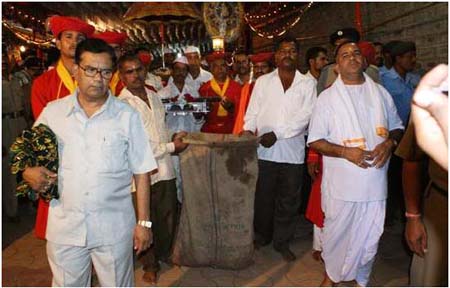
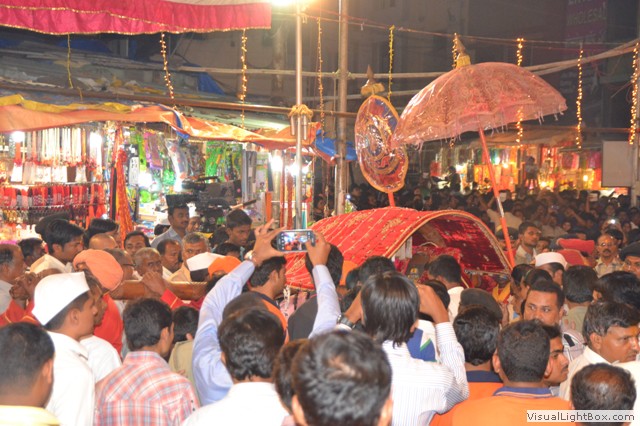
At about 5 PM the ceremony of Seemolanghan takes place. The word Seemolanghan consist of two words Seema (Border) and Ullanghan (Crossing it) Centuries ago kings practiced this. If they crossed their border first and attacked the neibhbouring kingdoms, it would result in a fewer fatalities and loss of land. For the nine days of Navarathri, the king fasted and performed Devi Pooja and on Dasara (10th Day) they crossed their border and attacked. Lord Rama crossed the border on Dasara day and set out to kill Ravana. It was on this day that Devi Durga killed the demon Mahishasura.
The priest from the Samadhi Mandir along with a multitude of devotees performs Seemolanghan. They carry ochre colored Nishan on a pole, this Nishan is garlanded, and Aarti is performed to it at the Dwarakamai. Then in procession they cross the border of Shirdi Village and enter the Khandoba Mandir. There Aarti and Pooja is performed to it. After the pooja is done Shami Leaves (Sona) is exchanged by one and all. The procession returns with the Nishan to the Dwarakamai and the Nishan is hoisted on the grill of the Sabhamandap.
Bhajans by various invited artists is held in the Samadhi Mandir the whole night. Samadhi Mandir is open the whole night.
Third Day: No Kakad Aarti. Gopal Kaala is performed followed by Noon Aarti.
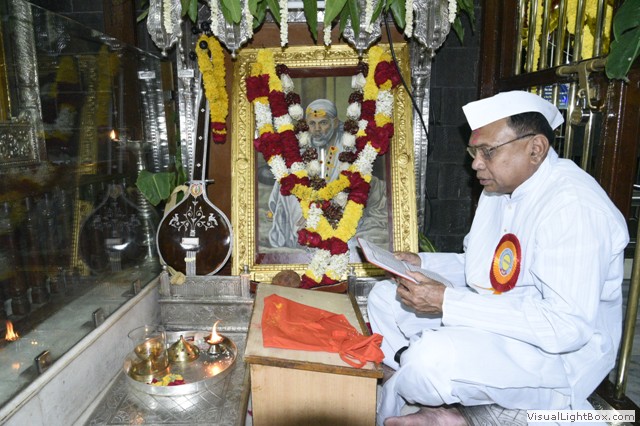
Satsatcharitra parayana in dwarakamai and Saibaba Punyatithi is celebrated in September/October on the day of Vijayadasami or Dusserah.
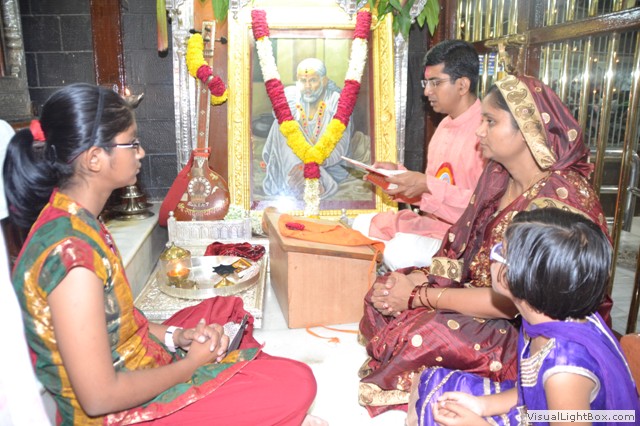
First Day: Akhand Parayan. Palki procession through the village Dwarakamai is kept open the whole night.
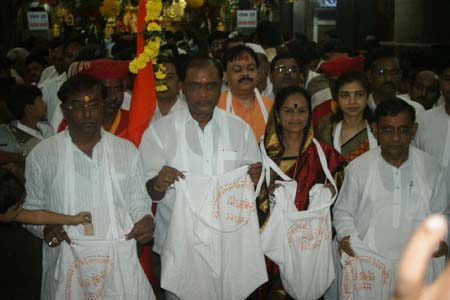
Second Day: "Biksha" A day before names of the devotees participating in the Biksha are taken by lottery. The devotees assemble in the Samadhi Mandir at 08.00 AM. They are garlanded and gheru jholies are given to them. They are brought in procession to Dwarakamai. After Lalkari they are taken to the five houses that Baba took Biksha from. On the way they accept Biksha from the devotees in return giving some of the contents from their jolies as Baba's prasad.
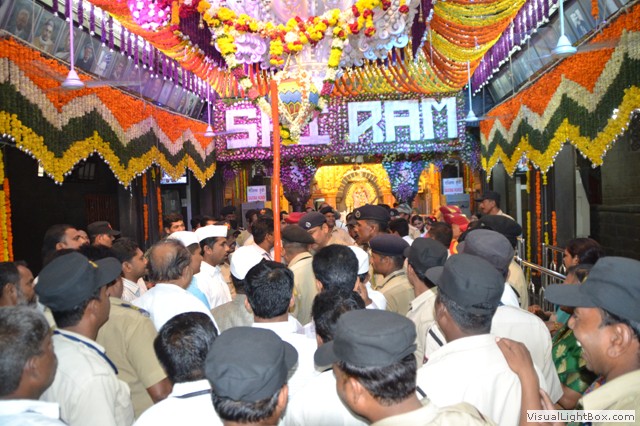
Third day gopal kaala will be celebrated.
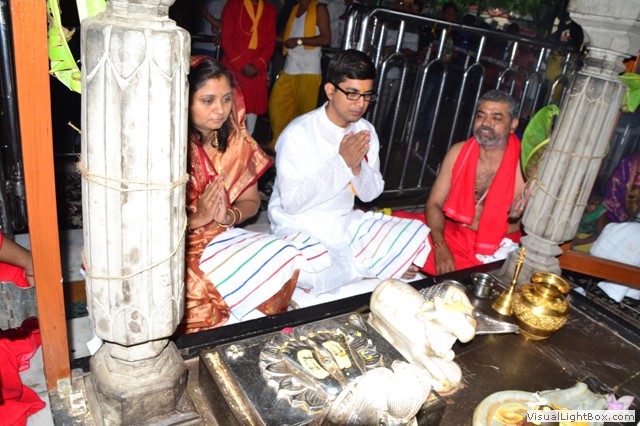
As well rudrabhisheka at gurustan
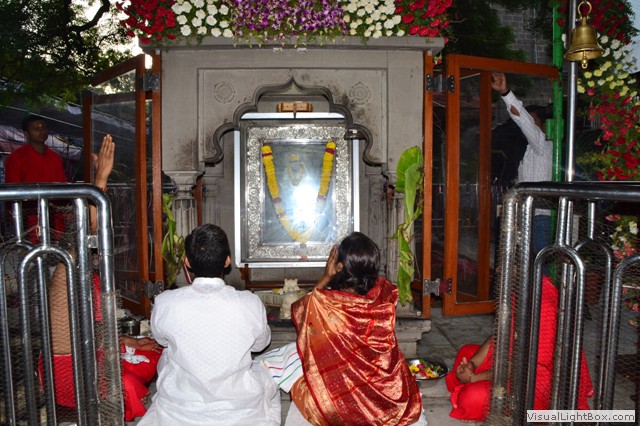
Priests will perform rudrabhisheka at the gutustan.
